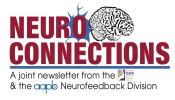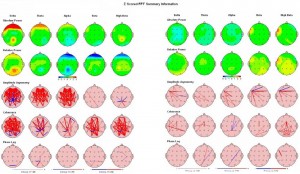 This article is a second in a 2-part series that further explains the practicalities of using Z-score [neurofeedback] training with multiple sites. For an explanation of the theory this is based upon, please refer to Part 1 of this series. Additionally, readers not familiar with Z-score neurofeedback may want to first read the article “Z-Score EEG Biofeedback: Conceptual Foundations” for an excellent introduction to this complex topic.
This article is a second in a 2-part series that further explains the practicalities of using Z-score [neurofeedback] training with multiple sites. For an explanation of the theory this is based upon, please refer to Part 1 of this series. Additionally, readers not familiar with Z-score neurofeedback may want to first read the article “Z-Score EEG Biofeedback: Conceptual Foundations” for an excellent introduction to this complex topic.
Some have worried that multivariable training with LZT is too complex for the trainee to comprehend. Quite the contrary. During the training, the subject is simply watching a DVD or animation, or playing a game, or listening to music or sounds. The complex protocol calculations still control all feedback as if there were just another training variable. The trainee experience can be whatever is conventional or familiar, relative to the “signaling” method. The brain readily seizes on information that relates to a well-targeted state, regardless of the metrics underlying the state. The fact that we can ride a bicycle demonstrates that we can readily integrate millions of bits of information into a cohesive whole, combined with the mind and body responses, and that it can become effortless. The more comprehensive the information, the more likely the brain is to understand and interpret it. And this is a brain process, not a conscious mental process.
This is not unlike the difference between simple muscle fitness training, versus a more comprehensive activity like dance or athletics. When applied in a comprehensive whole-head training approach, live Z-scores transform neurofeedback into an entirely different kind of experience for the brain’s self-regulatory mechanisms. Nonetheless, the trainee continues to watch movies, play simple games, listen to music, as before, and by allowing the training to occur, lets their brain learn a new and profound new set of activations and connections.
Currently, we encourage the majority of our users to use the comprehensive MVP method that incorporates all available Z-scores into a single metric. We have enhanced it to include selective training functions, such as training only a specific metric (absolute power, relative power, etc), or training a certain class of metrics (“all connectivity metrics”). In addition, we have included the ability to use different upper and lower limits. This was necessitated by the experience with a man who had excessive amplitudes overall, reaching the level of 2-3 standard deviations in the dynamic scores. When a window of + or – 3 standard deviations was used for training, the trainee’s EEG quickly changed to a very low amplitude EEG, and overshot the goal of zero. Therefore, we offered the ability to provide different limits, and the trainee was trained using limits of +3 and -1 standard deviations. This allowed effective feedback, while not rewarding the trainee for going too low.
Using a comprehensive approach, it also becomes possible to address the issue of normalization training versus peak-performance or mental-fitness training. Based upon our experience with various peak-performers, we have identified certain combinations of features that are unique to them. We also have subjective reporting data on individuals who undergo Z-score training, and who exhibit one or more of these characteristics. Certain characteristics are generally identifiable as “good” and which reflect optimal functioning for that individual (but not necessarily all individuals). Other characteristics may be observed, that are concordant with “complaints,” which might include issues with attention, mood, and so on (Collura et al., 2008).
The following figure shows an example of a display used in this approach. Despite the complexity of the underlying computations, the display and its interpretation are relatively simple. The system derives a metric which reflects a comprehensive analysis of all of the Z-scores, or a subset thereof. The metric becomes the training variable, thus replacing the conventional amplitude or connectivity-based metric, and is significantly more comprehensive than a single Z-score.
The interpretation of the overall success rate is identical to that in any operant conditioning paradigm, and reflects the aggregate reward being experienced by the user. The variables that can be adjusted to control feedback are the target size and the performance score required for the derived metric. In the example shown, the required score is 70.0 percent, and the trainee is achieving this goal 50.4 percent of the time, on average.

Figure 2 (click to enlarge): Typical indicator screen used with a Multivariate Proportional (MVP) training protocol. Top: white: MVP training parameter; green: MVP target percentage threshold (70%), red: cumulative percent time above threshold (50.4%). Middle: size of target in standard deviations (1.2), Bottom: event flag indicating the times when the MVP parameter is above threshold.
One benefit of MVP-based protocols is that they can be biased for peak performance. For example, among the attributes that may be selected for enhancement are global alpha coherence, resting motor strip SMR, reduced low-frequency coherence, or other variables. These protocols thus combine the concept of brain normalization with that of brain optimization.
We refer to the example case presented by Mark Smith (April issue). In this case, we have three NeuroGuide QEEG coherence maps obtained from a full 19-channel EEG assessment. The first map shows the trainee at an early stage in this training experience. Considerable coherence abnormalities (hypocoherences) are evident. The second map shows the effects of conventional targeted coherence training, using the following plan:
- Increase coherence of beta at F4/C4 to decrease seizures. (5 sessions)
- Increase coherence of delta at P3/T5 to decrease seizures. (5 sessions)
- Increase coherence of delta at F7/F8 to decrease seizures. (5 sessions)
- Increase coherence of beta at C4/F8 to decrease seizures. (5 sessions)
The effects of the training are evident. The targeted coherences have indeed moved toward normalization. However, many coherences that were not targeted have changed, and not for the better. Furthermore, delta coherences have become significantly worse. This demonstrates the potential hazards of targeting single coherence measures along single connectivity paths. The third (right) map shows the result after several sessions of z-score targeted coherence training. It is evident that the z-score approach is indeed capable of targeting and normalizing coherences, leading to whole-brain normalization.

Figure 3 (click to enlarge): NeuroGuide coherence maps of case of Jack (Smith, April issue) showing High Beta (top) and Delta (bottom) coherences before training (left), after a conventionally targeted coherence training regimen (middle), and after z-score training (right).
These advanced z-score training methods are implemented in software, and are applied “on top” of the basic live Z-score software that is built into the ANI DLL. This software is itself written in the form of a library, which can become available to other system developers who wish to incorporate this new form of training.
As an example of the ability to multivariate Z-Scores to resolve complex situations, the following pre- and post-treatment QEEGs are taken from a case that required only 23 sessions to produce the changes shown by Lambos and Stark (Collura et. al. 2008). The trainee was a 12 year-old boy with problems related to impulsivity, behavior, discipline, and hyperactivity. In amplitudes, he had abnormally high slow frontal activity, abnormally low fast frontal activity, and occipital abnormalities in delta and alpha. These also manifested as many significantly abnormal asymmetries. In addition, there was hypercoherence in essentially all frequency bands, and particularly at the very low and very high frequencies.
By using an MVP protocol, the clinicians were able to remediate essentially all of these abnormalities in 23 sessions, as shown on the QEEG. Interestingly, one small emerging abnormality appears in the form of left frontal beta and high beta. If anything, this slightly excessive activation of the left frontal lobe might reflect a benefit, which would be a brightening effect on the trainee’s mood. These results are taken from the eyes-open condition, which was the training condition. A different set of changes, also related to normalization of the EEG, was observed in the eyes-closed condition, indicating that the brain was learning self-regulation for both conditions, despite being trained with eyes-open only.

Figure 4 (click to enlarge): Pre- and Post-treatment NeuroGuide QEEG maps (eyes open) showing effects of 23 sessions of 4-channel Multivariate Proportional live Z-Score training.
Summary
The use of Z-Scores in itself is an important addition to neurofeedback, but it does not provide an “automatic” solution in and of itself. It is not necessarily applicable to every trainee, and the idea of training everyone “to the norm” is not universally applicable. It is necessary to understand and interpret the brain dynamics of the trainee, determine which types of normalization are appropriate, and design and use protocols that are suited to the case at hand. In general, simply using a Z-Score as a target is not sufficient to produce normalization. In many situations, it will be important to have a whole-head QEEG type of analysis for planning and interpretation of the LZT training. It is also important to wisely use multiple channels and multiple targets, in order to give the brain the information it needs to achieve comprehensive improvements in self-regulation.
Members of the International Society for Neurofeedback and Research (ISNR) receive NeuroConnections as a free benefit of membership. Healthcare professionals who specialize in neurofeedback, biofeedback or QEEG are encouraged to join ISNR to receive the full edition (in a full color printed format) of NeuroConnections and other member benefits. The above article was reprinted from NeuroConnections with permission from ISNR.
References:
Collura, T.F., Thatcher, R.W., Smith, M.L., Stark, C.R., and Lambos, W.A. (2008) Real-Time EEG Z-Score Training – Realities and Prospects, in: Evans, J., Arbanel, and Budzynsky, T., and Budzynski, H., Quantitative EEG and Neurofeedback, 2nd Edition, Elsevier, in press.
Smith, M.L., (2008) Case Study – Jack, NeuroConnections, April issue
Stark, C. R. (2008) Consistent Dynamic Z-Score Patterns Observed During Z-Score Training Sessions—Robust Among Several Clients And Through Time For Each Client, NeuroConnections, April issue.
Thatcher, R., (2008) Z Score EEG Biofeedback: Conceptual Foundations. NeuroConnections, April issue
Walker, J.E., Kozlowski, G.P., and Lawson, R. (2007) A Modular Activation/Coherence Approach to Evaluating Clinical/QEEG Correlation and for Guiding Neurofeedback Training: Modular Insufficiencies, Modular Excesses, Disconnections, and Hyperconnections, Journal of Neurotherapy, 11(1) 25-44.
Acknowledgment:
The author wishes to thank Michael L. Smith for helpful comments and input on this article.
Disclaimer:
The author has a financial interest in BrainMaster Technologies, Inc. The advanced multivariate targeting method described herein is patent pending in the US, Canada, and Europe
No comments yet.